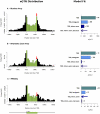Exon-specific QTLs skew the inferred distribution of expression QTLs detected using gene expression array data
- PMID: 22359548
- PMCID: PMC3281037
- DOI: 10.1371/journal.pone.0030629
Exon-specific QTLs skew the inferred distribution of expression QTLs detected using gene expression array data
Abstract
Mapping of expression quantitative trait loci (eQTLs) is an important technique for studying how genetic variation affects gene regulation in natural populations. In a previous study using Illumina expression data from human lymphoblastoid cell lines, we reported that cis-eQTLs are especially enriched around transcription start sites (TSSs) and immediately upstream of transcription end sites (TESs). In this paper, we revisit the distribution of eQTLs using additional data from Affymetrix exon arrays and from RNA sequencing. We confirm that most eQTLs lie close to the target genes; that transcribed regions are generally enriched for eQTLs; that eQTLs are more abundant in exons than introns; and that the peak density of eQTLs occurs at the TSS. However, we find that the intriguing TES peak is greatly reduced or absent in the Affymetrix and RNA-seq data. Instead our data suggest that the TES peak observed in the Illumina data is mainly due to exon-specific QTLs that affect 3' untranslated regions, where most of the Illumina probes are positioned. Nonetheless, we do observe an overall enrichment of eQTLs in exons versus introns in all three data sets, consistent with an important role for exonic sequences in gene regulation.
Conflict of interest statement
Figures

 “(AIC”) indicate better model fit, and the best model for each data set is indicated with a horizontal arrow. The labels for the four models indicate the different parameters included in each model: “TSS” refers to our basic distance model measured as distance from TSS; “intragenic” means that we use a single additional parameter for all SNPs within the transcript; “exon, intron” indicates that we use separate parameters for exonic and intronic SNPs respectively, and “last exon” indicates that we add an additional parameter for SNPs in the final exon.
“(AIC”) indicate better model fit, and the best model for each data set is indicated with a horizontal arrow. The labels for the four models indicate the different parameters included in each model: “TSS” refers to our basic distance model measured as distance from TSS; “intragenic” means that we use a single additional parameter for all SNPs within the transcript; “exon, intron” indicates that we use separate parameters for exonic and intronic SNPs respectively, and “last exon” indicates that we add an additional parameter for SNPs in the final exon.


Similar articles
-
High-resolution mapping of expression-QTLs yields insight into human gene regulation.PLoS Genet. 2008 Oct;4(10):e1000214. doi: 10.1371/journal.pgen.1000214. Epub 2008 Oct 10. PLoS Genet. 2008. PMID: 18846210 Free PMC article.
-
Genetic and epigenetic regulation of human lincRNA gene expression.Am J Hum Genet. 2013 Dec 5;93(6):1015-26. doi: 10.1016/j.ajhg.2013.10.022. Epub 2013 Nov 21. Am J Hum Genet. 2013. PMID: 24268656 Free PMC article.
-
Profiling RNA-Seq at multiple resolutions markedly increases the number of causal eQTLs in autoimmune disease.PLoS Genet. 2017 Oct 23;13(10):e1007071. doi: 10.1371/journal.pgen.1007071. eCollection 2017 Oct. PLoS Genet. 2017. PMID: 29059182 Free PMC article.
-
Understanding mechanisms underlying human gene expression variation with RNA sequencing.Nature. 2010 Apr 1;464(7289):768-72. doi: 10.1038/nature08872. Epub 2010 Mar 10. Nature. 2010. PMID: 20220758 Free PMC article.
-
Patterns of cis regulatory variation in diverse human populations.PLoS Genet. 2012;8(4):e1002639. doi: 10.1371/journal.pgen.1002639. Epub 2012 Apr 19. PLoS Genet. 2012. PMID: 22532805 Free PMC article.
Cited by
-
Japanese GWAS identifies variants for bust-size, dysmenorrhea, and menstrual fever that are eQTLs for relevant protein-coding or long non-coding RNAs.Sci Rep. 2018 May 31;8(1):8502. doi: 10.1038/s41598-018-25065-9. Sci Rep. 2018. PMID: 29855537 Free PMC article.
-
High-resolution mapping of cis-regulatory variation in budding yeast.Proc Natl Acad Sci U S A. 2017 Dec 12;114(50):E10736-E10744. doi: 10.1073/pnas.1717421114. Epub 2017 Nov 28. Proc Natl Acad Sci U S A. 2017. PMID: 29183975 Free PMC article.
-
Global properties and functional complexity of human gene regulatory variation.PLoS Genet. 2013 May;9(5):e1003501. doi: 10.1371/journal.pgen.1003501. Epub 2013 May 30. PLoS Genet. 2013. PMID: 23737752 Free PMC article. Review.
-
Heterogeneity of gene expression in murine squamous cell carcinoma development-the same tumor by different means.PLoS One. 2013;8(3):e57748. doi: 10.1371/journal.pone.0057748. Epub 2013 Mar 18. PLoS One. 2013. PMID: 23526950 Free PMC article.
-
A Methodological Assessment and Characterization of Genetically-Driven Variation in Three Human Phosphoproteomes.Sci Rep. 2018 Aug 14;8(1):12106. doi: 10.1038/s41598-018-30587-3. Sci Rep. 2018. PMID: 30108239 Free PMC article.
References
Publication types
MeSH terms
Grants and funding
LinkOut - more resources
Full Text Sources

